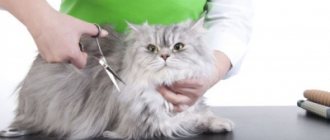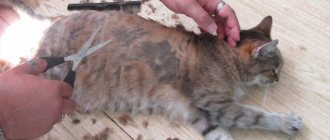Preparatory activities for the search
In order to return a missing cat, you must immediately begin searching after the loss is discovered. Pets often run away from home and fall off the balcony due to increased curiosity that arises against the background of hormone activity.
Successful searches largely depend on the implementation of certain preparatory activities:
- using a flashlight, since in the dark the eyes of cats display optical light, which helps to quickly locate the missing animal. During the search, it is necessary to explore the darkest and most secluded places, and when night falls, the pet can crawl out of its hiding place (for example, the basement of a residential building, ventilation, boiler room);
- binoculars and other optics. In such cases, you can detect your pet from a distance and not scare it off, as it may be in a highly stressed state. The devices allow you to thoroughly study the terrain within a range of several kilometers (dense thickets, forest, other hard-to-reach places);
- you can find a missing pet with the help of your favorite toys, since many cats observe surrounding activities from a hiding place and can jump out into the street at the sight of familiar and familiar objects;
- treats for cats. Shaking dry food in a can may be one of the cat's favorite sounds, so this method can also help in finding the animal;
- using a clicker, since the pet associates such a sound device with receiving a treat. If he hears these sounds, he can quickly return to his place of residence.
If a cat runs away from home, then its owner must pull himself together, calm down and plan the right search plan. Avoiding panic will give results faster and help you find your missing pet.
Main reasons for running away
There are several of them. The most popular is estrus, during which cats become uncontrollable, driven by the desire to mate, so animals even jump from high-rise balconies. The amazing ability of most cats to land on all fours saves them from death. But the owner loses his pet, so he is forced to go looking for him.
Accidental loss or escape for a cat is extremely stressful
Other popular reasons:
- hunting instinct. Cats by nature are created to catch birds and rodents, and the peculiarity of their visual apparatus is that they see a moving object very sharply. That is why a bird or fly flying outside the windows can cause a brave cat to jump after it;
- old age and illness. Cats often leave home to die alone. In this case, it is not necessary to look for the animal;
- accidental fall. Due to play or carelessness, a pet may fall out of a window or escape through an open door;
- resentment. This is the reason why animals kept in private houses with a fenced area may disappear. If the owner unfairly punishes the cat or gets a new pet, the offended animal may run away;
- a change of scenery. Many city residents decide to move their pet to the village or country house for the summer. However, the animal does not always understand that this is temporary; it believes that it has been abandoned, so it decides to rid the owner of its presence.
Note! In any case, no matter what reason prompts the cat to expand the boundaries of his world, you need to understand that he is experiencing extreme stress, is very afraid, and is waiting for his owner to be able to find him. Therefore, it is very important to know what to do if a cat goes missing and where to start looking for it.
Cats are hunters to the core, so they can accidentally fall out of a window while chasing a bird or insect.
Possible places where an animal can hide
Considering the issue of a domestic cat running away, how to find it requires studying the probable places of the loss. In practice, an animal can approximately hide in the following places:
- entrances from the upper floors, while at the same time you need to try to inspect baby strollers, buckets, shoes, other items located on landings, places near the garbage chute;
- basement, attic. In order to open these premises, you must contact the Housing Office and receive the keys to the doors;
- carrying out searches on the street, since cats love elevated places and can be on a tree, roof of a house, pole, balcony, tall bush;
- in winter, a cat can hide in places such as heating pipes, a car engine, or a heating radiator located in the entrance;
- possible search locations on the street (garage, shed, other utility rooms);
- in many cases, the animal gets lost on the street in hard-to-reach places, so storm drains, sewers, and drainpipes must be checked;
- When searching for a cat, a hungry animal is often found near trash cans and food preparation areas (a dining room kitchen or a cafe located near the house).
Possible places of loss in the house:
- inspection of furniture, closet, niche, space under the bed;
- the upper part of the closet, sideboard, furniture wall, since cats love to hide in these secluded places;
- empty boxes and other containers that can accommodate an animal;
- the window of the washing machine, which is constantly open and ventilated;
- balcony and adjacent structures.
Finding a cat in the country is much more complicated due to the large territory, great access to wild nature (proximity to a forest, river), and possible collisions with wild animals. In this case, the pet may take refuge in a neighbor’s house, so it is important to check this option.
During search activities, you need to call the animal by name, try to rustle it with its favorite food, or wear a toy that is familiar to it, as these factors can make the task easier and find the missing cat on the street.
How to find an animal on the street
Searching for a frightened animal is quite difficult, since a cat can hide in a secluded place for a long time (for 2-4 days), so it is necessary to organize a proper search and carefully check possible places.
Often the pet can be found in the company of street cats, as sex hormones play a role, and it is drawn to the street during the period of active mating games. If it is important that the animal is completely domestic, then it needs to be sterilized.
In some cases, after searching, the cat does not want to return home at all, so homemade traps (cardboard boxes or other suitable containers) may be needed.
A cat that finds itself in an unknown situation hides for a long time (for 5-6 days) and does not go outside. She starves and becomes unadapted to the conditions that arise.
At the same time, animals do not run away over long distances, so searches are best carried out within a radius of several kilometers from the house. Cats are under severe stress, so they may simply not respond to their name or favorite treat.
Cats that are lost on the street often like to hide under cars parked in the yard, so these places need to be checked first.
Make bait
Felines' sense of smell is much better developed than vision, so smell is an important landmark that can lure a lost pet.
Baits are placed within a radius of 100-200 meters from the house or a little further, preferably in places that can be checked regularly. You can use the following “beacons” for searching:
- the owner's things - the cat will be attracted by an old jacket or slippers with a familiar smell;
- a toy, bedding or other favorite thing - a pet can follow its own scent;
- a small amount of filler from the tray will remind you of the marked territory of the house;
- food or treats - you can use it, but be careful; most likely, the feeder will attract stray animals.
Walk around the marked points about two to three times a day; it is better not to get too close to them, but to observe from the side.
What to do if you couldn’t find your missing cat in the first days
When searching for a missing cat, it is not always possible to find it quickly, but you cannot abandon this idea and you need to continue the undertaking. Some recommendations:
- posting advertisements about searching for an animal in the area of residence, indicating external data, photographs, and the amount of reward. In this case, the form can be hung up in veterinary clinics located in the district;
- social networks (in contact, classmates), as there are special groups where you can post information about a missing animal. This technique is quite effective, since the ad can be read by a large number of people.
The above methods can help in the search even after a long time, since the animal can stray to any place.
At the same time, fraudsters can take advantage of such advertisements for their own benefit:
- a call is made and the owner is notified that his animal has been found;
- most often the voice of the person calling is absolutely calm, measured and does not arouse any suspicion;
- then the person demands a reward in a friendly tone with the transfer of the animal after some time (several hours, in the morning or in the evening);
- at the same time, scammers often ask to top up a card or mobile phone number as a reward, and then disappear;
- if the owner refuses to transfer the money, they may face threats (for example, kill the animal or not give it back, but throw it out into the street).
In order to prevent the development of such events, the following measures must be taken:
- ask for the possibility of providing a photo using any electronic resource (mms message, viber, mail, whatsapp);
- checking the name of the animal when naming it is incorrect and if the cat responds, then this is a fraudulent scheme;
- checking for special signs or finding out any other characteristic features of the animal. If confusion begins, then most likely it is just scammers trying to illegally receive a reward.
Useful tips
Useful tips from experts when searching for a missing animal:
- gradual expansion of the search area only after a thorough inspection of all local areas and other places located nearby;
- search activities are best carried out at different times of the day, since frightened pets can come out of their hiding places in the evening or at night, when it gets dark;
- calling your pet, using your favorite food, toys, or clicker is best used early in the morning or late in the evening, since it becomes quiet outside and the animal can hear familiar sounds and run towards them;
- It is best to carry out searches with assistants, since it is quite difficult to inspect vast areas alone. Additional help can speed up the receipt of positive news;
- finding out information from strangers (neighbors, children walking on the playground, pensioners on benches). You can show a photo of the animal, leave contact information and find out if anyone has seen it in the surrounding area;
- You can also contact janitors or permanent residents who often feed stray animals and may encounter a lost cat on their way.
Attract people
Searching for a missing animal alone is much less effective than searching with other people. First of all, contact your friends and relatives - they will be happy to help comb the area, and there is a chance that the smell of your friends will not scare away the cat.
It wouldn’t hurt to ask people who are constantly near your home for help - these could be janitors, salespeople at kiosks, or fitters. It is possible that they were among the first to notice a frightened animal nearby.
Children willingly participate in the search for missing pets. You can involve a group of schoolchildren walking in the yard in the search, but you must definitely warn them about following the rules of behavior - excessive activity and loud noises will frighten the cat even more.
What to do when a cat is found
If a missing cat is found, then at the first meeting he may experience discomfort and be in a stressful state due to a sudden change in circumstances and being in an unknown environment for a long time.
You need to approach the found animal carefully and show it a treat in order to lure it and not scare it away. A hungry animal will gradually approach the food and then you can carefully try to pick it up.
Once the animal has been found, it is necessary to inspect it and identify the possible presence of wounds, injuries, fleas and worms. Such activities are carried out when visiting a veterinary clinic.
At first, it is necessary to limit the amount of food, since a hungry animal can attack the food and then get severe digestive disorders. It is best to eat small meals up to several times a day.
Additionally, it is necessary to carry out preventive measures to prevent the repeated loss of the animal:
- access to the street must be limited for some time or regular monitoring of the animal must be ensured;
- it is necessary to accustom the cat to its nickname, which should be simple and not complicated. This will make it easier to find the animal if it gets lost;
- carrying out castration, sterilization, as the animal’s sexual instincts are dulled and it becomes calmer. However, this method does not eliminate the risk of it disappearing from home;
- installation of metal bars on windows, especially in multi-storey buildings, since their landing is not always successful for general health;
- the use of durable carriers, special harnesses instead of a collar when the owner and the cat move long distances;
- microchipping cats and having a special collar will help you quickly find them, since the chip indicates information about their place of residence;
- You can also try to teach the cat to walk outside so that he returns home on his own. However, it takes an indefinite amount of time to develop such a habit.
Caring for a foundling
Unfortunately, about half of the animals that escape from their homes are never found. But if the search brings results, the cat returns home, you should not only surround him with attention and affection. During the trip, the pet could communicate with stray cats and cats, could get hurt, or eat a low-quality product. He needs to be examined by a veterinarian:
- Tests will show whether there was any infection with parasites or dangerous viruses.
- A specialist will check at the veterinary clinic for the presence of wounds, including hidden ones.
- A doctor may prescribe a sedative for a cat if it is very frightened or in a state of stress.
- There is no need to overfeed your pet right away, even if he looks hungry. It is better to feed him light foods for a while so that the functioning of the gastrointestinal tract is improved.
- At a veterinary clinic, a specialist will prescribe medications to prevent fleas, ticks, and parasites. Processing must be carried out.
How long can it take for a missing cat to return?
Real-life cases show that lost cats can return home after several months or even years. According to statistics, up to 50% of lost owners find their pets healthy and unharmed.
65% of cases confirm the fact that cats return home from distant places (cottage, village or other places where the animal was early). Intensive searches, patience and perseverance increase the chances of finding the loss within a short time.
Therefore, if the cat suddenly disappears, then you need to immediately start searching in all possible places. In this case, the animal can return home on its own after some time. Much depends on the pet and the circumstances of each specific situation.
It's best to do your best and try to check all your options. The loss of a beloved pet is an unpleasant matter, but it can be resolved if you follow the recommendations presented.











